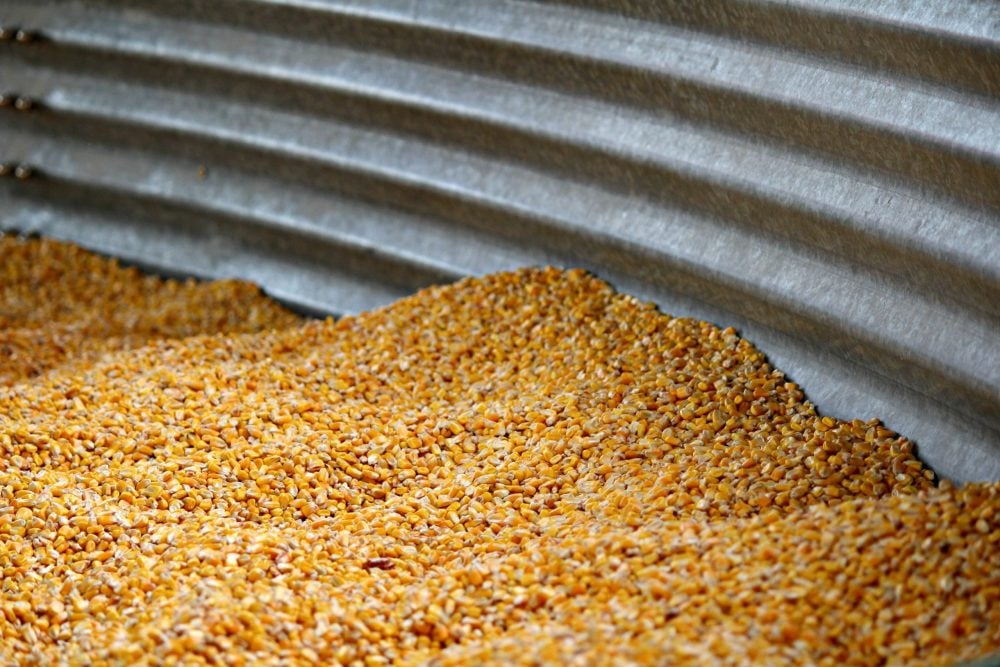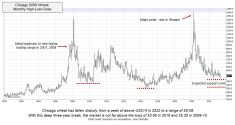The Ontario growing season received average precipitation in June and July and temperatures were two to three degrees below normal. Crop conditions favour trend type yields for corn, soybeans and wheat. Winter wheat harvest is in full swing. The corn crop has passed through the critical pollination phase. The forecast for the first half of August looks optimal for soybeans as the crop moves through the yield-determining pod-setting phase.
There are no concerns now about Northern Hemisphere crops. The U.S. and European winter wheat harvests are in the final stages and the Russian and Ukraine winter wheat harvests have experienced about two weeks of favourable weather. U.S. corn and soybean crop development has mirrored Ontario conditions.
The European corn crop will likely experience yield drag due to above normal temperatures and limited precipitation through pollination, but Europe is not a significant corn exporter. Brazil’s Safrinha corn harvest will finish up in the next few weeks. There are no concerns regarding Australia at this time although the harvest is five months away.
Read Also

Cycle swings dictate farming profitability
It can be profitable to understand where the crop markets are positioned in the context of their big-picture cycles.
The 2021-22 crop year will go down in history as one of the most volatile years for grain and oilseed prices. I hope producers kept notes as all the major events were developing. Besides the drought in Western Canada last summer, there were no significant declines in production from any major exporter.
There were major concerns about weather in South America and limited precipitation in the U.S. over the winter. On top of the usual weather concerns, markets were extremely reactionary to trade distorting measures. Crude oil prices traded near historical highs as the U.S. and world economies recovered from the COVID pandemic.
China’s start and stop procedures also resulted in commodity demand uncertainty. The Russian invasion of Ukraine caused grain and oilseed markets to rally from February through May. Once the 2022 Northern Hemisphere crops were planted and more certain, prices trended lower. The last half of August and first half of September is generally when corn, wheat and soybean markets make seasonal lows.
When producers email or call for advice or to discuss the markets, I often refer to personal experiences to explain the current situation. Recently a producer asked me to write about these experiences so Ontario farmers can put recent events into perspective.
Commodity traders always say there is nothing new in markets because human behaviour never changes. Markets are in the doldrums, with prices at 52-week lows. There are no selling recommendations at this time so I’m taking the producer’s advice and will share a few experiences and relate them to this past crop year.
Wars and outside influences cause markets to strengthen but the market always comes back down. The rally is an opportunity for cash sales.
Let me start with the most practical example. An old farmer friend of mine has two rules for trading futures. The first rule is to “always be long.” The second rule is “read rule number one.”
Only once did he go short on the canola futures market, in April 1986. There was a year-over-year increase in canola acres and conditions were excellent across the Prairies. He decided to sell 200 tonnes of canola on the futures as a hedge.
Then the Chernobyl nuclear disaster occurred on April 26, 1986. The futures went limit up three days in a row. The poor guy couldn’t get out of his position. Finally, on the fourth day, there was trade. He reversed and got long according to his rules. (You can imagine the torment in his mind.)
However, the day he went long, the market closed near the low of the day’s range. The media reported that all Russian, Ukraine, and European crops were inedible due to high radiation. Approximately seven days later, the market was back below his initial sell entry point. He exited his position because of large losses.
I was 14 years old at the time. The details and timeline may be off but you get the picture. This example is forever etched in my mind.
When wheat is limit up three days in a row, as we saw this past spring upon the Russian invasion, it’s an opportunity to sell into the strength. I wouldn’t have the courage to sell the futures but this was definitely an opportunity for cash sales. The point is that the market will eventually come back down to pre-war levels and lower.
Weather markets are selling opportunities. It’s never as bad as the media suggests.
The second example is from August 2004. I was a local on the trading floor in Winnipeg. Western Canada had the coldest April on record, the coldest May on record, the coldest June on record and the coldest July on record. We were all waiting for it and sure enough, a frost occurred on Aug. 19.
News reports suggested the crop was finished, even though the frost was only in eastern Saskatchewan and Manitoba. Canola futures rallied straight up from $300 per tonne to $380 per tonne.
There was a bit of a lull in trade so I phoned a few plant scientists in university agriculture departments to ask if the frost had hurt the crop. They said the crop was fine. Plant science professors said traders had underestimated canola yield because canola thrives under cooler conditions. They told me to expect record yields. Canola futures went straight down from $380 per tonne to eventually consolidate around $250.
As a rule, crops tend to yield better than expected when drier conditions occur. This is true especially for wheat. Last August, trade estimates had the Canadian non-durum spring wheat crop around 12 million tonnes and Statistics Canada confirmed a crop size of 16 million tonnes in December 2021. Brazil’s second corn crop experienced drier conditions this past spring but the crop will likely finish around 116 million tonnes.
The futures markets incorporate a risk premium due to uncertainty in production. As the crop becomes more certain, the risk premium erodes. The point is that weather markets are opportunities to make cash grain sales. Crops usually turn out better than expected.
At high prices, markets ration demand. Eventually, an upward trending market runs out of buyers. Farmers need to watch The Commitment of Traders Reports. When positions are at extremes, the markets tend to reverse.
The Commitment of Traders Disaggregated Report shows the positions of the commercials and the managed money. The commercial position is basically the position of grain companies and processors. The managed money is considered the non-commercial or speculative investment money involved in trading commodities.
On April 19, the managed money net long position on the corn market was 362,901, which was historically large. The May corn futures topped out during the week of April 29 at $8.27/ bushel. Even the speculative money has a limit and eventually, the market runs out of buyers.
The managed money has been liquidating since the week of April 28 and as of July 19, the managed money net long was only 106,625 contracts and the nearby September contract was at $5.75/bu.
On the flip side, the commercial short position on April 19 was a historically large at 754,360 contracts. The commercial short position reflects the cash position of grain companies. To make an analogy, when the commercial trader has a historically large short position, it’s like a 200,000-tonne elevator that is holding 199,900 tonnes. The company is unable to buy additional stocks because they’re full. Basis levels widen out and the market starts to deteriorate so that grain companies can liquidate stocks.
There is an old saying, “the market moves against the largest position of the herd. When everyone is on one side of the boat, the market goes in the opposite direction.” The point is that when the commercials and the managed money have an extreme position, the market is due to reverse course.
Periods of extreme highs are followed by periods of extreme lows.
It was June 2008. I was working as an export wheat merchant and I was visiting a customer in Egypt. We were at the port of Damietta looking at grain unloading facilities and storage. My Egyptian friend told me to put my arm into the pile of corn in a warehouse at the port. I did and it was cold. This was June 21 2008, the hottest day of the year at over 40 C. I asked “how does the corn stay so cool?” He responded calmly, “we’ve been storing grain in Egypt for thousands of years. We know how to store grain.”
I visited a flour miller in Hong Kong in spring 2008 when Minneapolis wheat futures were more than $22/bu. The flour miller was using Canadian hard red spring, but it was seven years old. They bought it out of government reserve storage.
In the book of Exodus, there is the story of Joseph in Egypt. Seven years of plenty were followed by seven years of want. This is one of the natural laws for commodity traders. The point is that extremely high prices are eventually followed by extremely low prices and vice versa.
Selling regular increments throughout the crop year increases the overall average selling price for the farmer.
In January, Ontario soybean prices were just over $17/bu. early in the month. Elevator soybean bids reached a high in late May at just over $22/bu. Analysts can have a good idea of grain and oilseed fundamentals but outside market influences are unpredictable. Keep this in mind.
Our strategy is to sell regular increments throughout the crop year to increase the overall average price. It’s impossible to pick the top. In most cases, the seasonal tendencies tend to hold but the extreme highs and extreme lows of the seasonal rallies can be enhanced by outside market factors that don’t influence the overall supply and demand picture.
My final word of advice is to keep notes. Price patterns and market behaviour repeat because human behaviour never changes.













